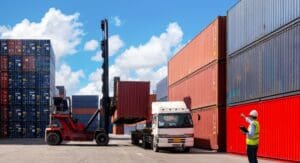Container handling equipment and technologies continue to advance changing the rules of how to move goods effectively across global supply chains.
This article explores what makes these innovations so important, the impact they have on the logistics industry, and how they are moulding the way goods are handled in the future.
Understanding Container Handling Equipment
For efficient port and terminal operation, container handling equipment is key across specialised machines that manage cargo container movement. Here is a breakdown of common types:
Gantry Cranes: Gantry cranes are normally utilised in port terminals to load and offload containers from ships and designed to work along rails and capable of moving heavy loads with precision.
Reach Stackers: Reach stackers are commonly known for their versatility and can move containers short distances across a facility.
Straddle Carriers: These vehicles move across and between container rows taking them and moving them over very short distances.
Container Tippers: Container tippers prove essential in container bulk material handling by facilitating easy unloading of material by tilting the container thus reducing offloading time.
Forklifts: Forklifts are used often in warehousing and distribution centres to handle smaller container loads. A good example is when they are required to move the goods to and from the container unit within a facility.
The Role of Technology in Enhancing Efficiency
Advanced technologies such as automation, robotics, artificial intelligence are added value in modern container handling systems. These are the innovations necessary for enhanced operational efficiency, precision and speed for minimising human errors and improving safety in risky operating environments. A clear example of this trend is seen in automated terminals, running with the minimum hands on the processes. These technologies enhance the productivity of container movement and set the boundary of what is possible in the logistics field, to maintain a new level of efficiency in terms of safety for the industry.
Sustainability in Container Handling
The development of modern container handling equipment is shifting towards sustainability. Manufactured machines are becoming more environmentally conscious while maintaining more significant levels of efficiency. The adoption of electric-powered handling equipment exemplifies this shift. Carbon emissions from these machines are reduced and meet the world’s most stringent global environmental standards. Electric technology allows terminals to reduce the environmental impact of their footprint reducing their ecological footprint in the logistics sector.
Challenges and Solutions
New challenges associated with introducing new container handling equipment include high initial costs, specialised technical skills and integrating advanced systems into the existing infrastructure. Overcoming these obstacles, however, can be frustrating but the long-term rewards include lower operational costs, increased efficiency and a smaller impact on the environment. The benefits outweigh the investment, time and effort needed to overcome the initial hurdles and allow organisations to achieve more sustainable and cost-effective operations over the long term.
Case Studies and Real-world Applications
The practical benefits of advanced container handling equipment are most evident at major ports such as Rotterdam and Singapore. Automated cranes and guided vehicles have been put in place, linked to a centralised system in these ports to rationalise container traffic. The benefit of this integration is improving operational efficiency and a reference for other ports that could want to develop their facilities. Systems of such nature show significant increases in throughput and operational reliability and establish a standard for port operations worldwide.
The Future of Container Handling
With the integration of digital technologies like the Internet of Things (IoT) and blockchain, the future of container handling is likely to be radically transformed. These innovations will improve cargo traceability and security, help cargo operations become more transparent and make operations more efficient. With the increasing global trade, the demand for innovative container handling solutions is estimated to increase further advancing in this domain. To learn more about container handling equipment, you can visit VAKO Transport Systems, which provides clients with the latest innovative logistics solutions.


















